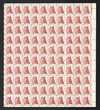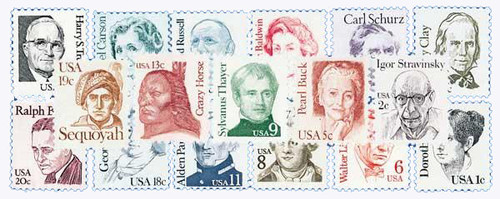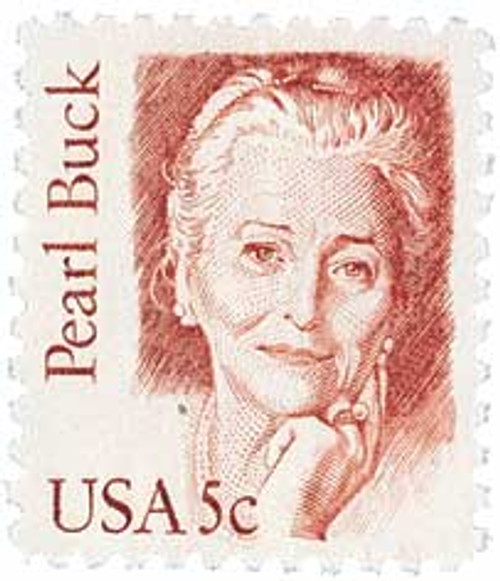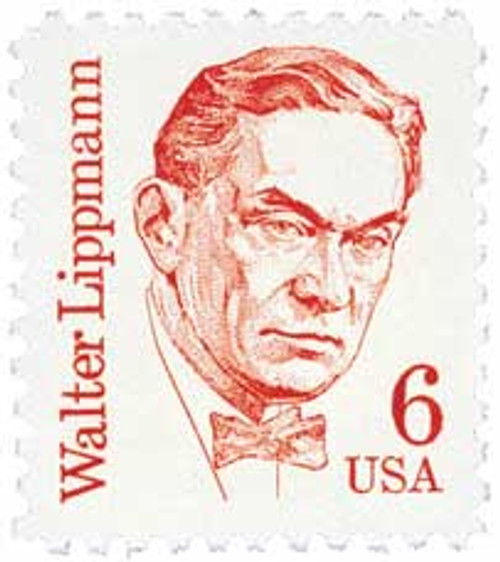
# 1855 - 1982 13c Great Americans: Crazy Horse
U.S. #1855
1982 13¢ Crazy Horse
Great Americans
- 6th stamp in the Great Americans Series
- Portrait based on the massive Crazy Memorial in South Dakota
- Honors the Lakota leader who led his warriors to victory at Little Big Horn
Stamp Category: Definitive
Series: Great Americans
Value: 13¢; postcard rate
First Day of Issue: January 15, 1982
First Day City: Crazy Horse, South Dakota
Quantity Issued: Unknown
Printed by: Bureau of Engraving & Printing
Printing Method: Engraved
Format: Panes of 100
Perforations: 11 x 10.5
Color: Light maroon
Why the stamp was issued: Issued to satisfy the new post card rate that went into effect on November 1, 1981
About the stamp design: First-time stamp designer Brad Holland based his pencil sketch of Crazy Horse on models of the massive Crazy Horse Memorial in South Dakota. Crazy Horse refused to have his picture taken, so the memorial’s sculptor based his model on descriptions provided by warriors who had fought alongside the Lakota leader.
First Day City: The First Day ceremony for this stamp was held at the Indian Museum of North America, within the Crazy Horse Memorial in the Black Hills of South Dakota.
About the Great Americans Series: The Great Americans Series was created to replace the Americana Series. The new series would be characterized by a standard definitive size, simple design, and monochromatic colors.
This simple design included a portrait, “USA,” the denomination, the person’s name, and in some cases, their occupation or reason for recognition. The first stamp in the new series was issued on December 27, 1980. It honored Sequoyah and fulfilled the new international postcard rate that would go into effect in January 1981.
The Great Americans Series would honor a wider range of people than the previous Prominent Americans and Liberty Series. While those series mainly honored presidents and politicians, the Great Americans Series featured people from many fields and ethnicities. They were individuals who were leaders in education, the military, literature, the arts, and human and civil rights. Plus, while the previous series only honored a few women, the Great Americans featured 15 women. This was also the first definitive series to honor Native Americans, with five stamps.
The Bureau of Engraving and Printing (BEP) produced most of the stamps, but private firms printed some. Several stamps saw multiple printings. The result was many different varieties, with tagging being the key to understanding them. Though there were also differences in perforations, gum, paper, and ink color.
The final stamp in the series was issued on July 17, 1999, honoring Justin S. Morrill. Spanning 20 years, the Great Americans was the longest-running US definitive series. It was also the largest series of face-different stamps, with a total of 63.
Click here for all the individual stamps and click here for the complete series.
History the stamp represents: Crazy Horse was a leader of the Lakota division of the Sioux Indians. Born near present-day Rapid City South Dakota, around 1842, he became known for his uncanny ability to avoid injury and death during battles.
Crazy Horse first showed his bravery against other Native American tribes. When white settlers began to encroach on his people’s land, he fought to preserve their way of life. At the Battle of Rosebud on June 17, 1876, Crazy Horse launched a surprise attack of about 1,500 Lakota and Cheyenne warriors against General George Crook and his troops. The battle claimed few lives, but kept Crook’s troops from joining George A. Custer a week later at the Battle of Little Big Horn.
On June 25, Custer led his cavalry in an attack against a Cheyenne and Lakota camp along the Little Bighorn River. Accounts from other Indians that day said that Crazy Horse “was the bravest man I ever saw. He rode closest to the soldiers, yelling to his warriors. All the soldiers were shooting at him, but he was never hit.” The Lakota and other Indian tribes were victorious in the battle, which took the life of General Custer.
In response to this defeat, the US government destroyed much of the Sioux land, forcing the residents to flee. That winter was difficult for the Native Americans, and Crazy Horse and his followers surrendered in May 1877. On September 5, Crazy Horse was involved in a scuffle with soldiers at Fort Robinson in Nebraska. He died of wounds he received. The chief is still revered among his people today.
The Crazy Horse Memorial – Black Hills, South Dakota
The Crazy Horse Memorial is a gigantic sculpture of the great American Indian chief Crazy Horse, mounted on a horse, which is being sculpted from a mountain in the Black Hills of South Dakota. Work began on the memorial in 1948. The carving will be 641 feet long by 563 feet high when completed. Crazy Horse’s head will stand over 87 feet high and the horse’s head is 22 stories high.
Crazy Horse never allowed his photograph to be taken. Rather than being an exact likeness, the figure in the sculpture is said to represent this remarkable leader’s spirit. Crazy Horse is depicted pointing over his horse’s head. This was done to symbolize Crazy Horse’s well-known statement: “My lands are where my dead lie buried.”
Korczak Ziolkowski (1908-1982) was the driving force behind the creation of the memorial. This self-taught artist experimented with sculpting in wood and stone as a young man. He developed a reputation as a studio sculptor and joined the National Sculpture Society. Korczak briefly worked as an assistant to Gutzon Borglum, creating Mount Rushmore National Memorial. That year, the artist also completed the marble sculpture “Paderewski: Study of an Immortal,” which won a contest by popular vote at the New York World’s Fair.
That victory led to Lakota Chief Henry Standing Bear’s inviting Korczak to create the Crazy Horse Memorial in the Black Hills. Despite being injured several times during construction, Korczak worked on this project until his death. Progress on the memorial continues under the Ziolkowski family and the Crazy Horse Memorial Foundation.
U.S. #1855
1982 13¢ Crazy Horse
Great Americans
- 6th stamp in the Great Americans Series
- Portrait based on the massive Crazy Memorial in South Dakota
- Honors the Lakota leader who led his warriors to victory at Little Big Horn
Stamp Category: Definitive
Series: Great Americans
Value: 13¢; postcard rate
First Day of Issue: January 15, 1982
First Day City: Crazy Horse, South Dakota
Quantity Issued: Unknown
Printed by: Bureau of Engraving & Printing
Printing Method: Engraved
Format: Panes of 100
Perforations: 11 x 10.5
Color: Light maroon
Why the stamp was issued: Issued to satisfy the new post card rate that went into effect on November 1, 1981
About the stamp design: First-time stamp designer Brad Holland based his pencil sketch of Crazy Horse on models of the massive Crazy Horse Memorial in South Dakota. Crazy Horse refused to have his picture taken, so the memorial’s sculptor based his model on descriptions provided by warriors who had fought alongside the Lakota leader.
First Day City: The First Day ceremony for this stamp was held at the Indian Museum of North America, within the Crazy Horse Memorial in the Black Hills of South Dakota.
About the Great Americans Series: The Great Americans Series was created to replace the Americana Series. The new series would be characterized by a standard definitive size, simple design, and monochromatic colors.
This simple design included a portrait, “USA,” the denomination, the person’s name, and in some cases, their occupation or reason for recognition. The first stamp in the new series was issued on December 27, 1980. It honored Sequoyah and fulfilled the new international postcard rate that would go into effect in January 1981.
The Great Americans Series would honor a wider range of people than the previous Prominent Americans and Liberty Series. While those series mainly honored presidents and politicians, the Great Americans Series featured people from many fields and ethnicities. They were individuals who were leaders in education, the military, literature, the arts, and human and civil rights. Plus, while the previous series only honored a few women, the Great Americans featured 15 women. This was also the first definitive series to honor Native Americans, with five stamps.
The Bureau of Engraving and Printing (BEP) produced most of the stamps, but private firms printed some. Several stamps saw multiple printings. The result was many different varieties, with tagging being the key to understanding them. Though there were also differences in perforations, gum, paper, and ink color.
The final stamp in the series was issued on July 17, 1999, honoring Justin S. Morrill. Spanning 20 years, the Great Americans was the longest-running US definitive series. It was also the largest series of face-different stamps, with a total of 63.
Click here for all the individual stamps and click here for the complete series.
History the stamp represents: Crazy Horse was a leader of the Lakota division of the Sioux Indians. Born near present-day Rapid City South Dakota, around 1842, he became known for his uncanny ability to avoid injury and death during battles.
Crazy Horse first showed his bravery against other Native American tribes. When white settlers began to encroach on his people’s land, he fought to preserve their way of life. At the Battle of Rosebud on June 17, 1876, Crazy Horse launched a surprise attack of about 1,500 Lakota and Cheyenne warriors against General George Crook and his troops. The battle claimed few lives, but kept Crook’s troops from joining George A. Custer a week later at the Battle of Little Big Horn.
On June 25, Custer led his cavalry in an attack against a Cheyenne and Lakota camp along the Little Bighorn River. Accounts from other Indians that day said that Crazy Horse “was the bravest man I ever saw. He rode closest to the soldiers, yelling to his warriors. All the soldiers were shooting at him, but he was never hit.” The Lakota and other Indian tribes were victorious in the battle, which took the life of General Custer.
In response to this defeat, the US government destroyed much of the Sioux land, forcing the residents to flee. That winter was difficult for the Native Americans, and Crazy Horse and his followers surrendered in May 1877. On September 5, Crazy Horse was involved in a scuffle with soldiers at Fort Robinson in Nebraska. He died of wounds he received. The chief is still revered among his people today.
The Crazy Horse Memorial – Black Hills, South Dakota
The Crazy Horse Memorial is a gigantic sculpture of the great American Indian chief Crazy Horse, mounted on a horse, which is being sculpted from a mountain in the Black Hills of South Dakota. Work began on the memorial in 1948. The carving will be 641 feet long by 563 feet high when completed. Crazy Horse’s head will stand over 87 feet high and the horse’s head is 22 stories high.
Crazy Horse never allowed his photograph to be taken. Rather than being an exact likeness, the figure in the sculpture is said to represent this remarkable leader’s spirit. Crazy Horse is depicted pointing over his horse’s head. This was done to symbolize Crazy Horse’s well-known statement: “My lands are where my dead lie buried.”
Korczak Ziolkowski (1908-1982) was the driving force behind the creation of the memorial. This self-taught artist experimented with sculpting in wood and stone as a young man. He developed a reputation as a studio sculptor and joined the National Sculpture Society. Korczak briefly worked as an assistant to Gutzon Borglum, creating Mount Rushmore National Memorial. That year, the artist also completed the marble sculpture “Paderewski: Study of an Immortal,” which won a contest by popular vote at the New York World’s Fair.
That victory led to Lakota Chief Henry Standing Bear’s inviting Korczak to create the Crazy Horse Memorial in the Black Hills. Despite being injured several times during construction, Korczak worked on this project until his death. Progress on the memorial continues under the Ziolkowski family and the Crazy Horse Memorial Foundation.



















